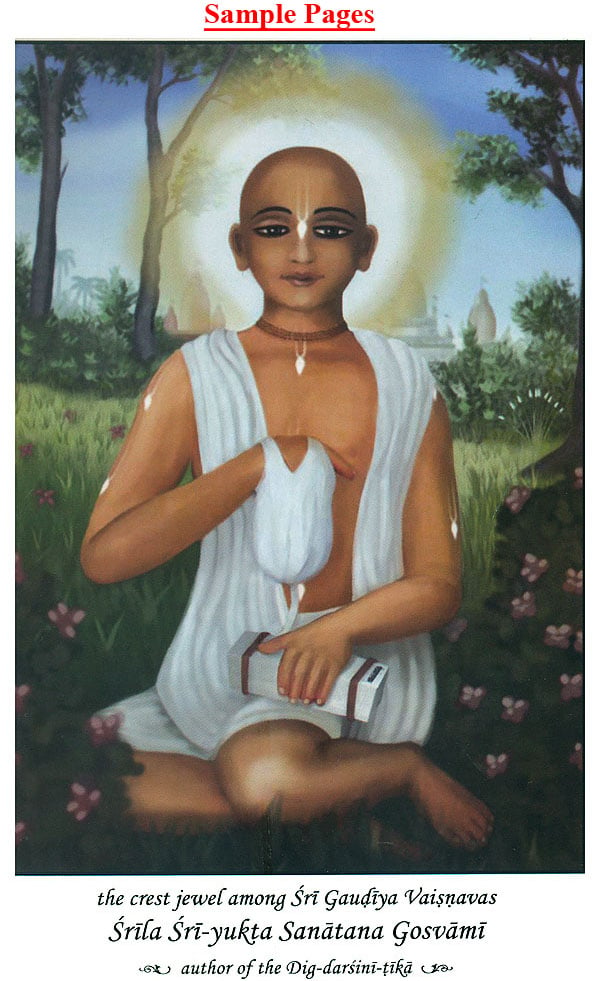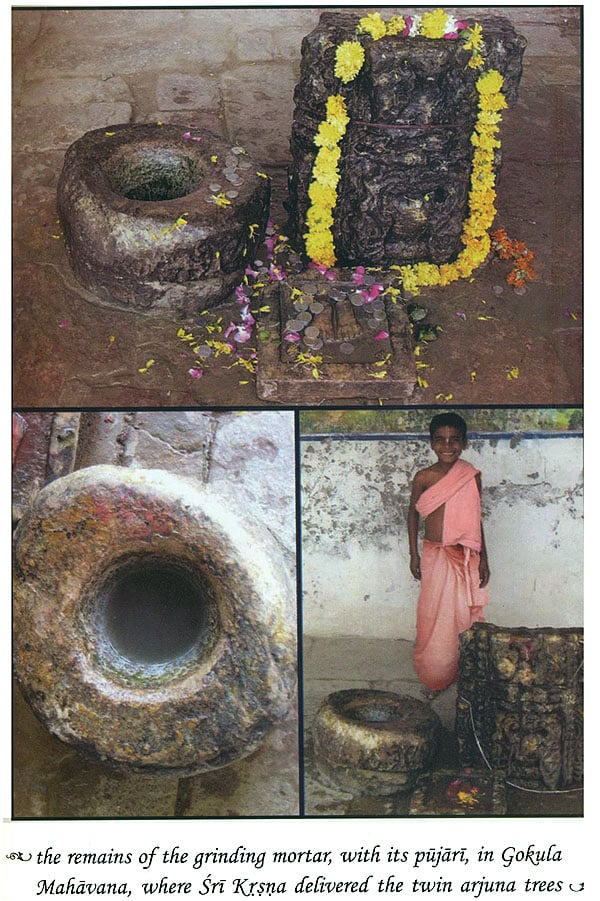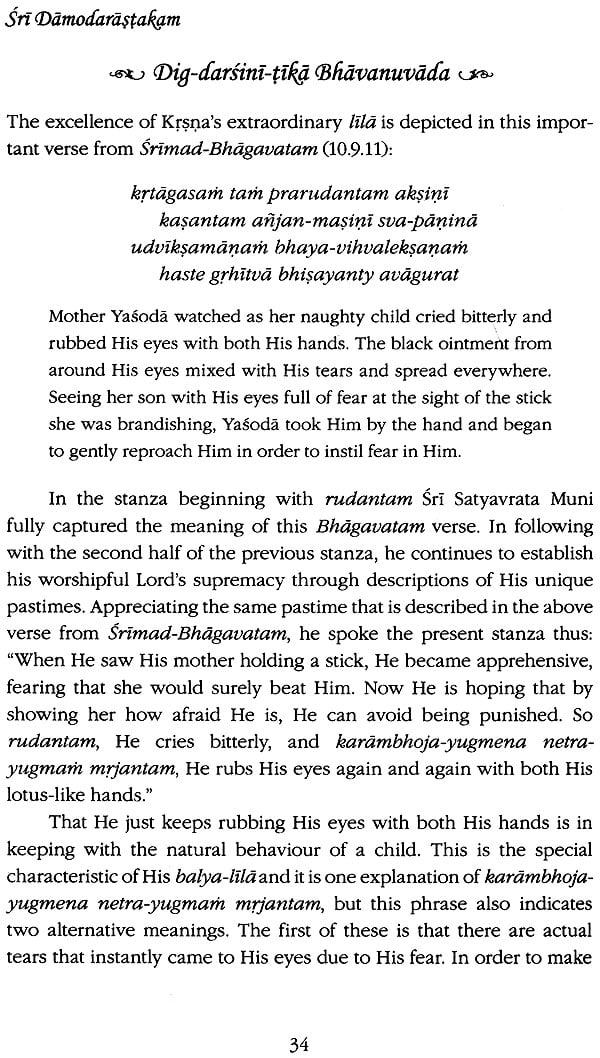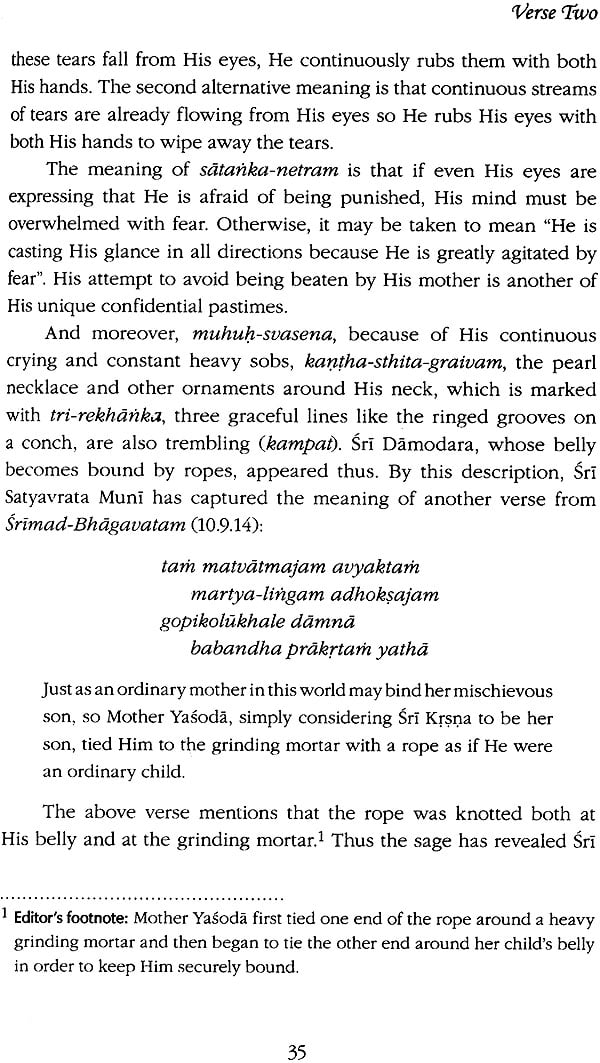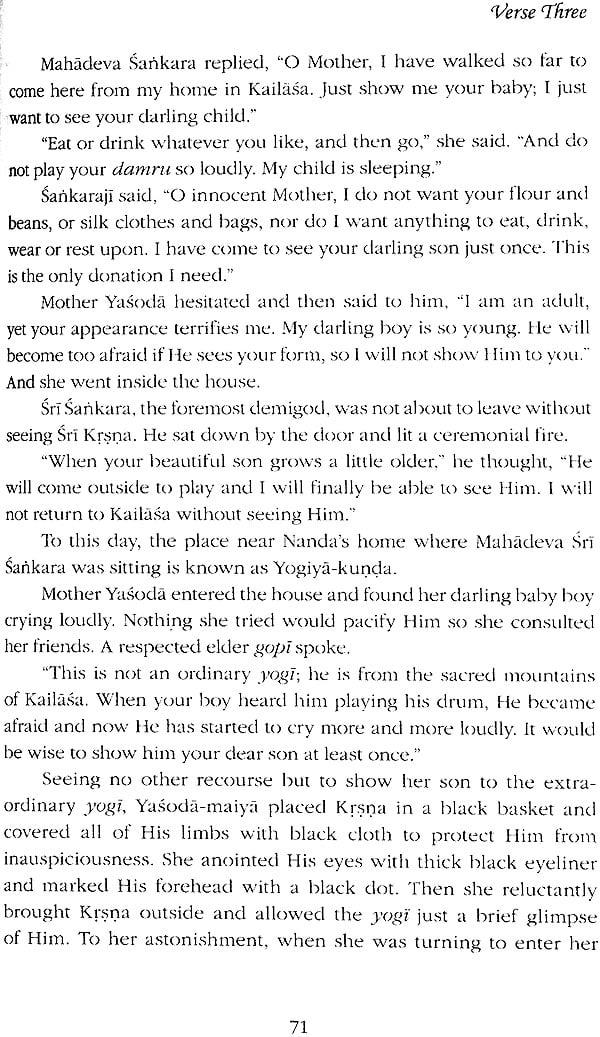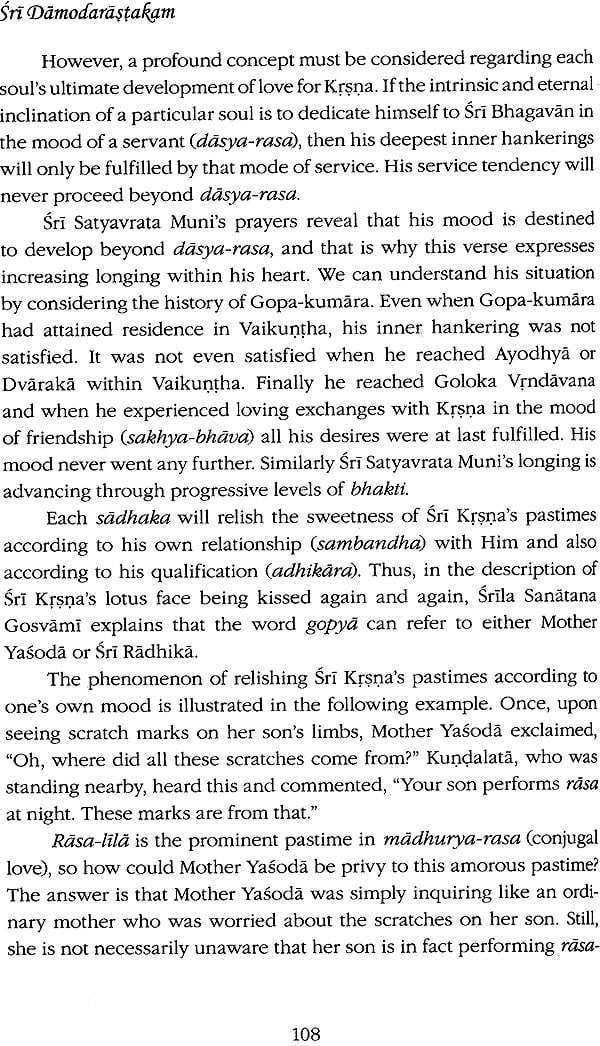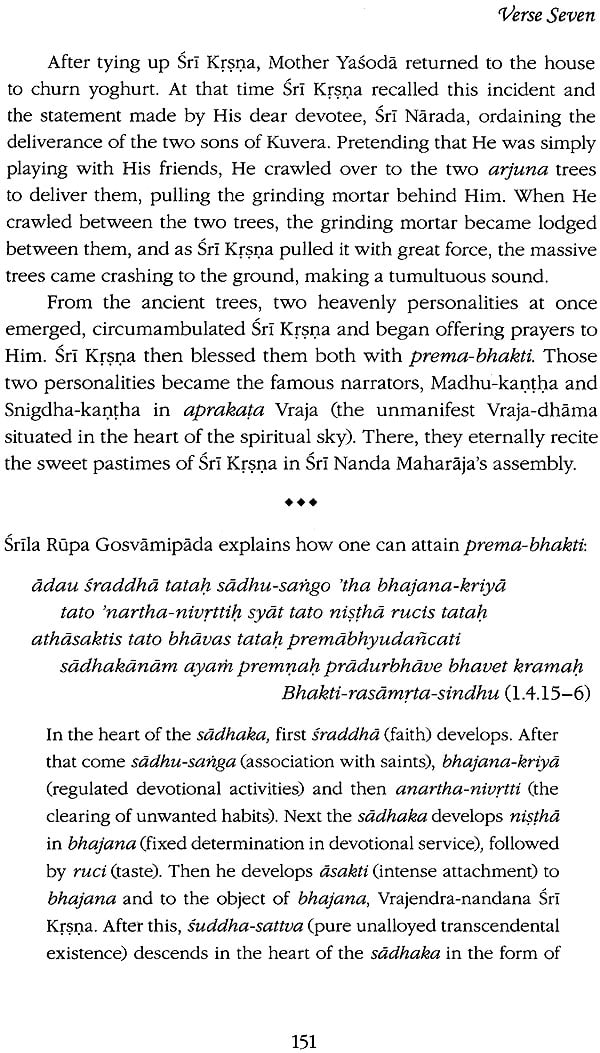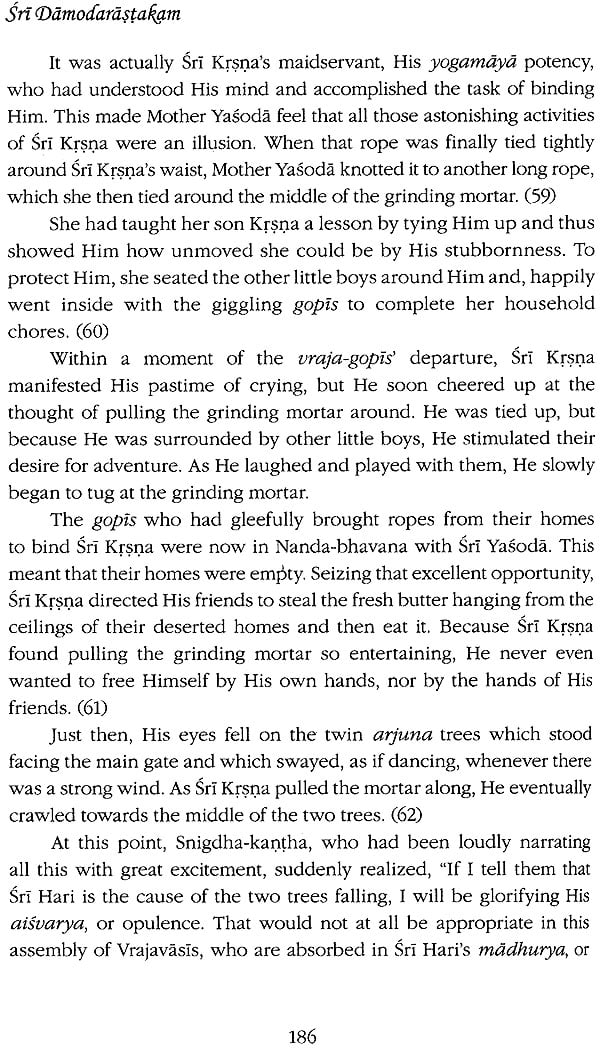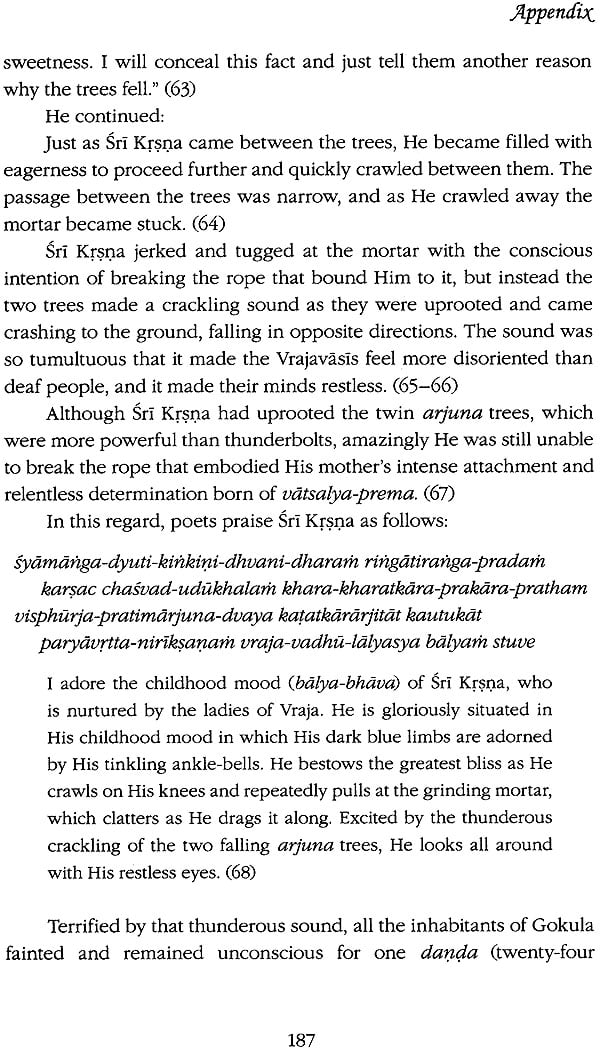
Sri Damodarastakam (Krsna - Controlled by Love and Affection)
Book Specification
| Item Code: | NAN767 |
| Author: | Sri Krsna Dvaipayana Vedavyasa |
| Publisher: | Gaudiya Vedanta Publications |
| Language: | Roman Text with Word-to-Word Meaning English Translation |
| Edition: | 2011 |
| ISBN: | 9788186737385 |
| Pages: | 231 (10 Color Illustrations) |
| Cover: | Paperback |
| Other Details | 8.5 inch X 5.5 inch |
| Weight | 290 gm |
Book Description
For a long time, I have been nurturing the desire to publish this Sri Damodarastakam. When we used to gather together, especially every Kartika month while observing Damodara-vrata, we would regularly become absorbed in singing Sri Damodarastakam in unison. At such a time, the strong desire to make its secrets bloom within the hearts of all the sadhakas would arise within me.
Sri Damodarastakam is eternal; therefore we should study it, sing it out loud, and discuss it, not just during the month of Kartika, but every day throughout caturmasya. It is so important that it is worth reading every month and indeed every day of the year. If this Sri Damodarastakam is glorified in a sublimely poyre way, Sri Damodara will become pleased. It is with this intention that with great effort we have compiled this book.
Sri Damodar-vrata, which is observed for the entire month of Kartika, is the most important vrata for Gaudiya Vaisnava. It has become famous by the name Damodara because Sri Krsna’s pastime of being bound with rope by His mother took place during this month. Dama means “rope” and Bandhana means “to Bound’, thus this pastime is known as Sri dama-bhandana-lila.
Sri Satyavrata Muni’s eternally perfect Sri Damodarastakam is part of the padma Purana which was recorded by Sri Krsna Dvaipayana Vedavyasa. This Astakam, or prayer comprising eight verses, reveals many deep and fundamental secrets about this beautiful pastime. Therefore all of our gaudiya acaryas have prescribed that we sing it every day during the month of Kartika if we are serious about pleasing Kartiki Srimati Radhika, the presiding Goddess of the month of Kartika.
Singing this astakam every day during the month of Kartika is so vital that Srila Sanatana Gosvami, the crest jewel among Sri Gaudiya Vaisnavas, has written a lucid and penetrating commentary on it, known as the Dig-Darsini-tika. In 1954, NItya-lila-pravista om visnupada astottara-sata Sri Srimad Bhakti Prajnana Kesava Gosvami Maharaja, the founder of Sri Gaudiya Vedanta Samiti, published this book in the Bengali language after very carefully translating and annotating Srila Sanatana Gosvami’s commentary. And our own beloved Srila gurudeva, parivrajakacarya tridandi- svami Sri Srimad Bhaktivedanta Narqayana gosvami Maharaja, who is the best among the disciples of Srimad Bhakti prajnana Kesava Gosvami Maharaja, has translated the former edition into Hindi, with an additional commentary called the Dig-darsini-vrtti. Under his guidance this English rendition is now being presented.
Once, during the month of Kartika, Srila gurudeva read Sri damabhandana-lila from Srila Jiva Gosvampada’s Gopala-campuh to his spiritual master, Sri Srimad Bhakti Prajnana Kesava Gosvami Maharaja exhibited rare ecstatic symptoms. With Srila gurudeva’s permission, we have English for the first time, as an appendix to the present edition of Sri Damodarastakam, along with Srila gurudeva’s brief recount of the afore-mentioned history.
In the Bengali edition by Sri Srimad Bhakti prajana Kesava Gosvami Maharaja, there are many footnotes and parenthetical statements clarifying the Dig-darsini-tika. In this English edition therefore all of these clarifications are marked by square brackets in Verse six and one in Verse Eight. We have marked all of our own footnotes in this English edition as “Editor’s footnotes”. Where direct English translations of Sanskrit terms have been provided, standard parentheses have been used.
Svayam Bhagavan Sri Krsnacandra, The original Supreme Lord, who possesses unlimited inconceivable potencies, allows Mother Yasoda to bind His waist with rope. In this way He fully relishes the very essence of the sweetness of her immaculate humour of parental love (vatsalya-prema-rasa) for him, and graces the worked with the ultimate example of His subservience to His devotees. He manifests that supremely charming pastime of being bound around His waist (Sri damabhandana lila) during the month of Kartika on the first day of the bright fortnight. This is the principle reason why the supremely blessed month of Kartika has become famous by the name “Damodara”.
Acaryapada Sri Gopala Bhatta Gosvami Compiled Sri Hari Bhakti-vilasa, which is the smrti-sastra, or law-book’, of the vaisnavas. There, he has outlined the devotional activities to be observed during the month of Kartika. He points out the injunction to daily worship Sri Radha-Damodara and to recite the stotra (Prayer) Sri Damodarastakam:
Radhaikam pratimam viprah pujayet karttike tu yah
Tasya tusyati tat-prityai sriman damodarau harih
O learned brahmanas, one who worships the deity of Sri Radhika for Her Pleasure, during the month of Kartika, equally satisfies Sri Damodara hari.
“damodarastakam” nama stotram damodararcanam
Nityam damodarakarsi pathet satya vratoditam
One whoworships sri damodara during kartika month by daily reciting the prayer Sri Damodarastakam, which was uttered by Sri satyavrata Muni as it arose in his hear, will perpetually attract Sri Damodara Himself.
As stated above, Sri Damodara Hari becomes pleased with those who worship Sri Radhika for her pleasure during the month of Kartika.
This Sri Damodarastakam Stava is narrated in the padma Purana, where it is spoken by Sri Satyavrata Muni in the context of a conversation between Sri Narada and other sages headed by Sri Saunaka Rsi. In his commentary on this Sri Damodarastakam, Srila Sanatana gosvamipada has stated.
“This prayer is nitya-siddha, which means ‘eternally perfect.’
It has manifested through Sri Satyavrata Muni and Is capable of attracting Sri Damodara-Krsna”.
In his extensive explanation, which is replete with his personal realizations, Srila Sanatana gosvami has thoroughly revealed this prayer’s ability to attract Sri Damodara.
For a long time, I have been nurturing the desire to publish this Sri Damodarastakam. When we used to gather together, especially every Kartika month while observing damodara-vrata, we would regularly become absorbed in singing this Sri Damodarastakam in unison. At such a time, the strong desire to make its secrets bloom within the hearts of all the sadhakas would arise within me. Furthermore, many bhaktasadhakas have also insistently requested me to published it. Now after so long, Sri Damodarastakam’s original Sanskrit verses, synonyms and Srila Sanatana Gosvamipada’s Sanskrit commentary called dig-darsini have been published. For readers who do not know Sanskrit, the Bengali translations of the original verses and the above mentioned commentary by Srila Sanatana Gosvami have been included in this book.
In the present age it is noticed that many scholars whose intelligence has been spoiled by Kali have a spiteful outlook towards the propagation of the Sanskrit language. Nevertheless, we have still published this Sanskrit works, Sri Damodarastakam, desiring to benefit the entire country. Literary scholars of the Bengali language must always keep in mind that if we are to promote the Bengali language, Sanskrit is our only support. As Sanskrit literature is promoted, Bengali literature is also certain to progress. Those who imagine that Bengali will be promoted while overstepping Sanskrit literature are gravely mistaken. We notice that the language of such scholars is unsystematic in every respect. The freedom of the Bengali language is subordinate to Sanskrit. In other words, it is not absolutely autonomous; rather it is paratantra-svatantra, its independence relies on Sanskrit. With this principle in mind, we are presenting this book to intellectual circles.
If one examines the manner in which Sri Damodarastakam conveys philosophical concepts, the excellence of its composition, the astonishing way in which it unfolds this pastime, and other aspects of this astaka, which was written down by Sri vyasadeva, it is obvious that it is an excellent work in the world of literature.
| Foreword | ix |
| Preface to the original Bengali Edition | xi |
| Sri Damodarsatakam | xxix |
|
|
|
| Namamtsvaram Saccidananda rupam | 1 |
|
|
|
| rudantam muhur netra-yugmam mrjantam | 31 |
|
|
|
| itidrksva-lilabhir ananda-kunde | 53 |
|
|
|
| Varam deva moksam na moksavadhim va | 75 |
|
|
|
| Idam te mukhambhojamavyakta nilair | 103 |
|
|
|
| namo deva damodarsananta visno | 117 |
|
|
|
| Kuveratmajau baddha murtyaiva yadvat | 143 |
|
|
|
| namaste'stu damne sphurad dipti dhamne | 155 |
| Appendix | 171 |
| Glossary | 195 |
